Arguments based on appeal to authority are not regarded as strong, especially in the sciences. Bioscientists would ideally defer first toward authority of evidence instead of the evidence of authority. As Sherlock Holmes cautioned, theory ought to follow data, not vice-versa. On the other hand, academic and translational scientists do love to gleefully advance the horizon of knowledge—and are incentivized to publish as a badge of their lab and institution’s credibility! Thus, RoosterBio recently updated its survey of some of the “meta-data” of scientists who published while using our materials and/or biosolutions expertise across our company’s history. This blog aims to showcase the hundreds of publication journeys recorded by our long-cherished [1, 2] academic research customers…and let these stories speak for themselves.
Increases of RoosterBio Citations within Various Science-Related Publication Categories
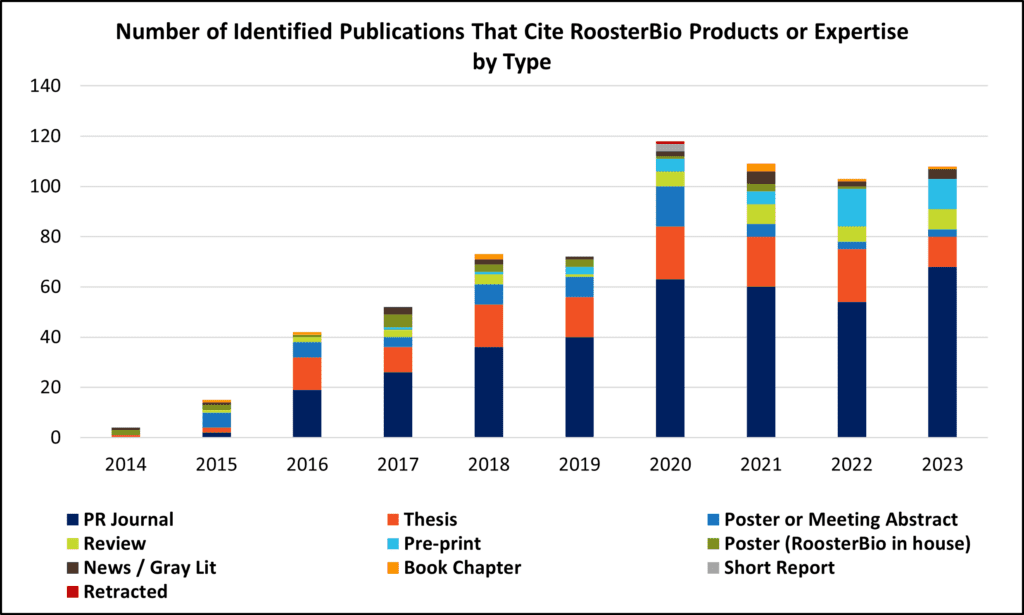
Figure 1. RoosterBio steadily increases its presence across different categories of publication (2014-2023): peer-reviewed science research articles (PR Journal), reviews, pre-print research articles (e.g., bioRxiv.org), graduate theses, posters, and meeting abstracts (via RoosterBio or external), book chapters, short reports, or news and “gray lit” (e.g., technical trade magazines, etc.).
We scoured PubMed, PubMed Central, Europe PMC, Google Scholar, Lens.org, and the journal Cytotherapy for all identifiable in-text mentions of “RoosterBio” per publication, as well as bioRxiv for preprint publications that have been awaiting peer-review. We imported all these into Clarivate™ EndNote™, then exported the list into Excel and de-duplicated the entries, removing redundant titles. Where possible, we filled in empty data cells manually and classified each entry publication according to the best-fit category (Figure 1, above). We also discarded entries that were deemed “false positives,” where the RoosterBio name was only tangentially related to the major focus of the text (e.g., a multi-abstract page with many institutions, or an advertisement).
Given the abundance of paywalls—and the variety of different export formats from the varied depots of online scientific scholastic data—it was impossible to fully capture what’s likely to be a larger actual tally. Nevertheless, what we did observe was an increasing trend of investigators who’ve successfully used RoosterBio products and/or expertise since our founding in Fall 2013. [3] These mostly comprise customers who are with academic research labs or clinical translational centers. Such a list might overlook our other distinct customers who are less incentivized to “publish or perish” and hail from stealthy pre-commercial biotech startups or research tools provider companies. The latest count to date (12/31/23) numbers 697 science publications, 368 of which are peer-reviewed research publications. Other categories include graduate theses (133), posters or meeting abstracts (80, including RoosterBio scientists), pre-prints that are not yet peer-reviewed (43), review articles (39), book chapters (9), and short reports (3).
Evidently, there was a lopsided bolus of publications in the years 2020 and 2021, more than in 2022. In accord with some of our customer feedback, we suspect this might be due to the impact of the COVID-19 pandemic. During these challenging months, some researchers spent less energy at the benchtop and more time dusting off half-finished manuscripts and navigating them through rounds of review. Refreshingly for us, we note that 2023’s “RoosterPubs” strongly rebounded with the highest annual count yet of peer-reviewed science research journal articles (68). Looking into the early days of 2024, we project another robust year with compelling studies and exciting new proofs of concept expositing technology based on exosomes and MSCs (mesenchymal stem/stromal cells).
Although it’s tempting to boast about presence in peer-reviewed journal research articles, we’re especially proud of young scientists who have used our cellular materials and media for their thesis work. Sure, some of us can wax nostalgic about post-graduate study—but recall that it might also be a very anxious chapter in one’s life? Aren’t M.S. and PhD grad students stressed enough? RoosterBio aims to make students’ or postdocs’ lives more hassle-free with its consistently high-performing cellular, media, and exosome/EV products. It thus is rewarding to observe such work boosting over 130 early careers. Incidentally, we’ve found numerous examples of thesis-related content reformatted for publication in leading scientific journals or prospective patent application figures for innovative pre-commercial biotech startups.
One exemplar of RoosterBio’s solid foundation for career trailblazing involves Dr. Hanna Strobel’s 2018 PhD thesis from Worcester Polytechnic Institute as an IGERT Fellow in the lab of Biomedical Engineering Professor Marsha Rolle. Dr. Strobel advanced the state of the art with fabricated smooth muscle cell (SMC) ring units for the generation of tissue-engineered blood vessels (TEBVs). It turns out that SMCs differentiated from MSCs express superior levels of contractile proteins vs. primary aortic SMCs and are easier to work with. MSCs on these rings can adjoin, assembling into functional tubes that are cohesive enough to be cannulated and strong enough for culture on a luminal flow bioreactor. A portion of these studies was also published in Tissue Engineering: Part A in October 2018. [4] Dr. Strobel would later continue her career as a Scientist at Advanced Life Solutions in Manchester, New Hampshire, where additional experiments via RoosterBio’s MSC materials were performed, yielding a 2021 publication in the journal Biofabrication related to vascularized adipocyte organoids. [5]
Some Authors Return for Second Helpings
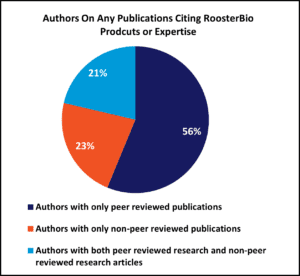
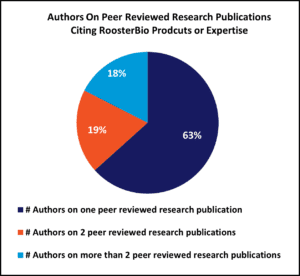
Figure 2. Left, Almost 80% of authors in RoosterBio-related science literature publish in peer-reviewed research journal articles. Right, At least one-third of authors in RoosterBio-related, peer-reviewed research articles return to publish more than one article with RoosterBio cells, media, or expertise.
From a scientist’s perspective, one feature of a shinier CV might be a track record to demonstrate contributions across varied publication formats. This demonstrates that a job candidate might be a versatile communicator and function as a team player. Many authors in publications that mention RoosterBio aren’t just aiming for a Science or PNAS article; they’re also invited to show thought leadership in review articles and to make contacts while exhibiting fresh data in poster or speaker abstracts at conferences like ISEV or ISCT. In Figure 2 (above left), we note that around 40% of authors in identifiable RoosterBio-citing works are found beyond peer-reviewed research articles.
From our commercial perspective, what’s not more satisfying than seeing customers return to work on new publishable units with the help of our products? In Figure 2 (above right), we notice that at least one-third of authors can be found on more than one peer-reviewed research article that cites us. This is not the whole story. There are also eighteen authors who have published five or more times in RoosterBio-citing articles. One of these has been published in thirteen of such articles.
With the last several years’ acceptances for NIH-funded grants remaining stubbornly flat at around 20%, it might be tempting to spend consumable cellular and media materials with a “shoestring” budget mentality that might initially reward with low price but penalizes with low quality. In contrast, RoosterBio assists the hMSC or exosome/EV investigator with high-quality, ready-to-use cell vials that contain bulk quantities of cells (e.g., 10-50 million per unit, or more). When factored on a cost-per-million cell basis, these larger aliquots remain the least expensive hMSCs readily available, which often are only otherwise purchasable in smaller units. With cells paired to RoosterBio high-performance expansion media, [6] the least costly and fastest route to one billion+ cells comes within reach. We salute the science investigators who have the prescience to “think big” and absorb slightly more upfront cell culture reagent cost by committing to RoosterBio’s product system of optimized reagents and bioprocess. For them, the savings in time is immediate—and the penalty of “hidden costs” can be swiftly steered clear. [7, 8] Our observation that some valuable authors embrace RoosterBio for multiple published studies would suggest that this company exceeds a threshold of quality, even for the budget-minded academic.
RoosterBio-Backed Science Investigators Aim High in Journal Submissions
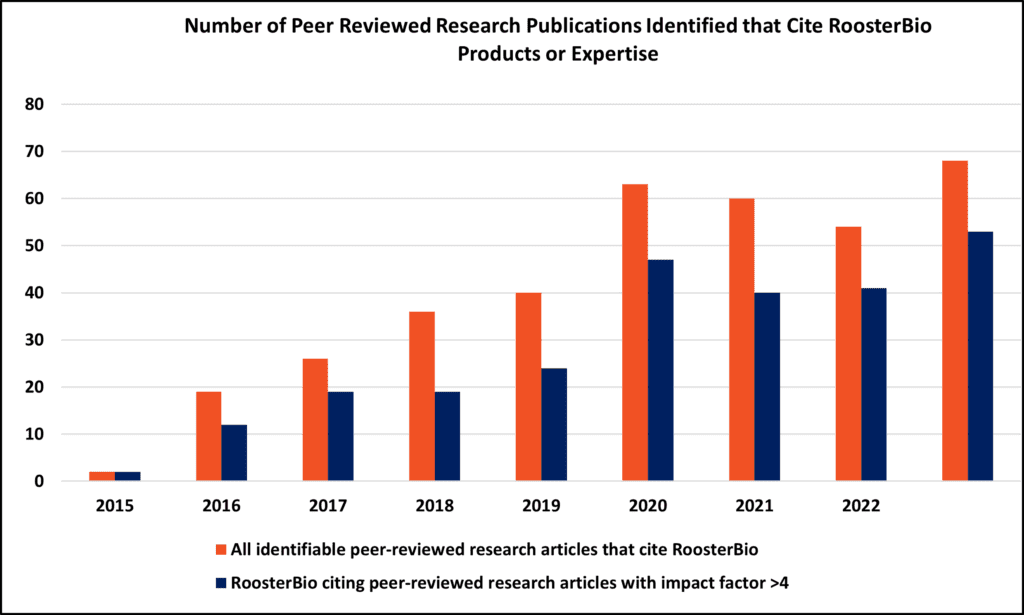
Figure 3. Above, “non review” (i.e., experimental research), peer-reviewed articles that cite RoosterBio products and/or expertise appear in journals with favorable (>4) ISI/Clarivate Impact Factors (IFs). The number of research articles published by journals with IFs >4 tends to increase since 2015, while the percentage fraction of >4 IF journals remains consistently high (72% -/+ 14%, SD).
Well-cited publications bring prestige to primary investigators (PIs) in bioscience. The decision to aim for publishing in a higher impact factor journal is a trade-off between the risk of rejection (or onerous revisions) on the one hand but possible obscurity via a less-competitive journal on the other. A journal title with ISI/Clarivate Impact Factor (IF) of 4.0 means that an author who publishes might expect to see approximately four citations by other articles in two years’ time; this figure is estimated from the prior two years of citations and articles published. We estimate that over 72% (-/+14%) of peer-reviewed research publications that give attribution to RoosterBio are in journals whose most recently calculated IF is greater than 4.0.
| Journal (Abbreviated Title) | Articles | Most Recent Impact Factor |
| Science | 1 | 56.9 |
| Adv Mater | 1 | 29.4 |
| Nat Biomed Eng | 2 | 29.2 |
| Am J Respir Crit Care Med | 1 | 24.7 |
| Circ Res | 1 | 20.1 |
| Advanced Functional Materials | 1 | 19.0 |
| Commun Phys | 1 | 17.7 |
| ACS Nano | 1 | 17.1 |
| Bioact Mater | 3 | 16.9 |
| Nat Commun | 3 | 16.6 |
| NPJ Regen Med | 1 | 15.2 |
| Nucleic Acids Res | 1 | 14.9 |
| Nat Protoc | 1 | 14.8 |
| Sci Adv | 2 | 14.1 |
| ACS Biomaterials Science & Eng | 1 | 14.0 |
| Biomaterials | 10 | 14.0 |
| Biosens Bioelectron | 1 | 12.6 |
| Mol Ther | 3 | 12.4 |
| Small Methods | 1 | 12.4 |
| Dev Cell | 1 | 11.8 |
| Journal (Abbreviated Title) | Articles | Most Recent Impact Factor |
| Clin Cancer Res | 1 | 11.5 |
| Cancer Res | 1 | 11.2 |
| Proc Natl Acad Sci U S A | 3 | 11.1 |
| J Nanobiotechnology | 1 | 10.2 |
| Cancer Immunol Res | 1 | 10.1 |
| Adv Healthc Mater | 10 | 10.0 |
| Acta Biomater | 12 | 9.7 |
| Acta Biomaterialia | 2 | 9.7 |
| Cell Biosci | 1 | 9.6 |
| ACS Appl Mater Interfaces | 4 | 9.5 |
| ACS Appl Mater Interfaces | 2 | 9.5 |
| Biofabrication | 7 | 9.0 |
| J Dent Res | 1 | 8.9 |
| Cell Reports | 1 | 8.8 |
| Mol Ther Nucleic Acids | 1 | 8.8 |
| Front Immunol | 4 | 8.8 |
| Mol Metab | 1 | 8.6 |
| Cell Rep Phys Sci | 1 | 8.4 |
| Int Journal of Bio Macromolecules | 2 | 8.2 |
| Mater Today Bio | 3 | 8.2 |
Table 1. Above, A “Top 40 List” of journals with high impact factors via investigators who published therein and cited the use of RoosterBio materials and/or expertise. Several RoosterBio-citing publications appeared more than once under each of these journal titles.
While an IF of 4.0 or higher is hardly obscure, many articles that explicitly contained “RoosterBio” in text are accepted into still higher-tier publications, including celebrated powerhouses like Science, Nature Biomedical Engineering, Circulation Research, Nature Communications, NPJ Regenerative Medicine, and PNAS. A “Top 40 Greatest Hits Impacts List” of these prestigious journal titles can be referenced in Table 2, above. This list may be a sign that primary investigators can achieve notoriety by partnering with RoosterBio, and leveraging its products and domain expertise across research areas that use mesenchymal stromal/stem cell and exosome/EVs.
What Are Researchers Investigating?
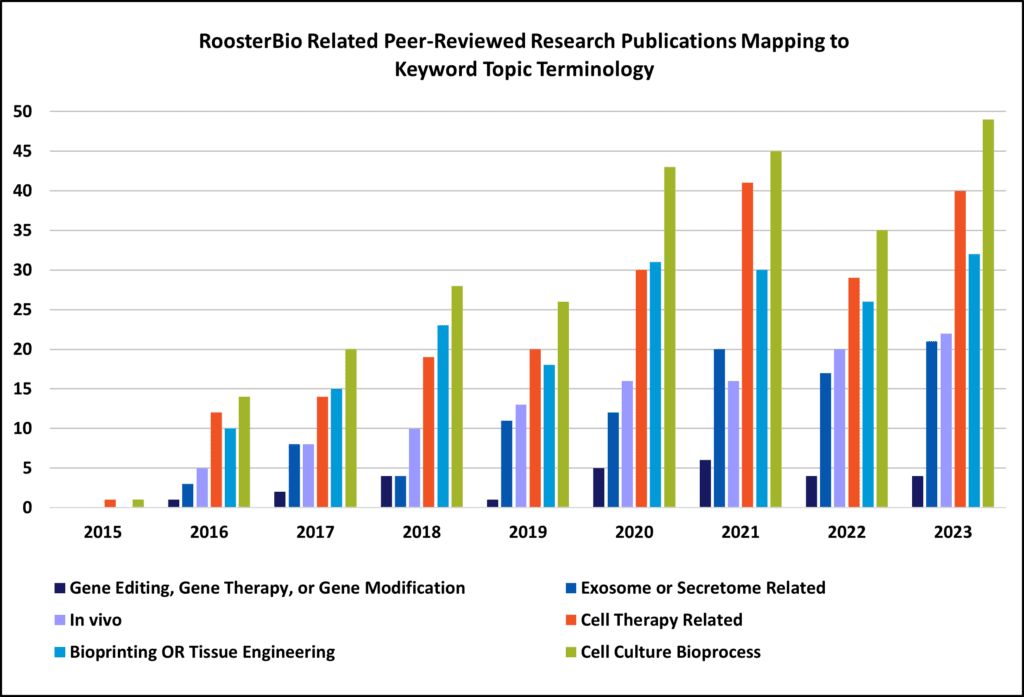
Figure 4. Above, inferred diversity of article content mined from abstract and/or title keywords. Some subject areas may overlap with others. Article sources for these data are peer-reviewed research articles that report the use of RoosterBio products and/or expertise within the text.
RoosterBio began in 2013 [3] with a mission to provide high-quality and bioprocess-friendly primary cells of clinical relevance (i.e., human mesenchymal stromal/stem cells, hMSCs) to the regenerative medicine research community. [9] It’s thus no surprise that the areas of publication involving RoosterBio closely relate to items of key interest to hMSC researchers: bioprinting and tissue engineering, cell therapy, and advanced cell bioprocess. Although tissue engineering publications have been an area of solid focus, it is curiously worth noting that “cell therapy” targeted keywords mapped to more journal articles over the last 3 consecutive years. This might be due to late-2010s rollout of RoosterBio cell and media products that are of GMP grade—poised to facilitate rapid entry into the clinic [10] backed by Type II US FDA Biologics Master files to cross-reference for new IND applications. In addition, as RoosterBio expanded the scope of its available customer solutions by ~2020, we also witnessed increases in publication topics related to gene editing and genetic modification, exosomes and/or extracellular vesicles (EVs), and in vivo (e.g., animal studies) applications of hMSCs. As RoosterBio further grows [11, 12] its customer roster of academics, clinical translation centers, biotech therapeutic innovators, and biotools companies, we anticipate entirely new categories of publication to report on in future editions of this blog.
Elementary My Dear Watson
“It is a capital mistake to theorize before one has data. Insensibly one begins to twist facts to suit theories, instead of theories to suit facts.” Sherlock Holmes in A Scandal in Bohemia
– Arthur Conan Doyle
After consuming this blog with an open mind, you’ve now completed some important “Holmes-work.” 😉 This blog has walked you through you some “clues” in the form of gathered data to help answer smaller questions that may add up to a bigger picture, a theory. These include:
- How often do science publications appear that cite RoosterBio materials or expertise in their text?
- Via this list of publications, how is the lit classified, and in what frequencies do publications appear in different categories?
- How often do individuals author works that cite RoosterBio?
- What is the range of publications that’s likely to be of higher impact?
- What topics do these publications report on?
With these key questions now answered with hard data, one can be intellectually armed. A coherent theory can be formed about how RoosterBio meets the needs of its academic research customers—perhaps all its customers? If suitable, we invite you to put this theory to the test! Yet before reaching out, please peruse the ongoing updated list of affiliated publications found on our website. With some inspiration and a little perspiration, perhaps your lab can also be part of this growing community of top-notch science!
References
- Candiello, Joseph. RoosterBio Products Continue to Expand Presence in Major Mesenchymal Stem/Stromal Cell (MSC)-related Regenerative Medicine Peer Reviewed Publications. 2018; Available from: https://www.roosterbio.com/blog/roosterbio-products-continue-to-expand-presence-in-major-mesenchymal-stem-stromal-cell-msc-related-regenerative-medicine-peer-reviewed-publications/.
- Candiello, Joseph. RoosterBio Products Continue to Support hMSC-Related Peer-Reviewed Publications in a Growing Number of Applications. 2020; Available from: https://www.roosterbio.com/blog/roosterbio-products-continue-to-support-hmsc-related-peer-reviewed-publications-in-a-growing-number-of-applications/.
- Olsen, T. R. and J. A. Rowley, Corporate profile: RoosterBio, Inc. Regen Med, 2018. 13(7): p. 753-757. 2217/rme-2018-0092
- Strobel, H. A., Hookway, T. A., Piola, M.; Fiore, G. B.; Soncini, M.; Alsberg, E.; Rolle, M. W., Assembly of Tissue-Engineered Blood Vessels with Spatially Controlled Heterogeneities. Tissue Eng Part A 2018, 24 (19-20), 1492-1503. 1089/ten.TEA.2017.0492
- Strobel, H. A., Gerton, T., Hoying, J. B., Vascularized adipocyte organoid model using isolated human microvessel fragments. Biofabrication 2021, 13 (3). 1088/1758-5090/abe187
- Snyder, J., Carson, J. The Story Behind the Media. 2022. Available from: https://www.roosterbio.com/blog/the-story-behind-the-media/.
- Lembong, J., Kirian, R., Takacs, J. D., Olsen, T. R., Lock, L. T., Rowley, J. A., Ahsan, T., Bioreactor Parameters for Microcarrier-Based Human M4SC Expansion under Xeno-Free Conditions in a Vertical-Wheel System. Bioengineering (Basel) 2020, 7 (3). 3390/bioengineering7030073
- Schultz, U., Newman, R., Rowley, J., Pijuan-Galito, S., Ross, J., Cell culture media: ask the experts, 2019; Available from RegMedNet: https://www.regmednet.com/cell-culture-media-ask-the-experts/
- Videos & Webinars. 2023; Available from: https://www.roosterbio.com/videos-and-webinars/.
- , A., Alvaro, D. Accelerating the Development of a Novel Cell Therapy for COVID-19–Associated Lung Fibrosis. 2021; Available from: https://www.pharmasalmanac.com/articles/accelerating-the-development-of-a-novel-cell-therapy-for-covid-19-associated-lung-fibrosis.
- Olsen, T. R., et al., Peak MSC-Are We There Yet? Front Med (Lausanne), 2018. 5: p. 178. 3389/fmed.2018.00178
- Snyder, J., Carson, J. The Sun Never Sets on a World Spinning with hMSC Advanced Therapeutics. 2022; Available from: https://www.roosterbio.com/blog/the-sun-never-sets-on-a-world-spinning-with-hmsc-advanced-therapeutics/.
